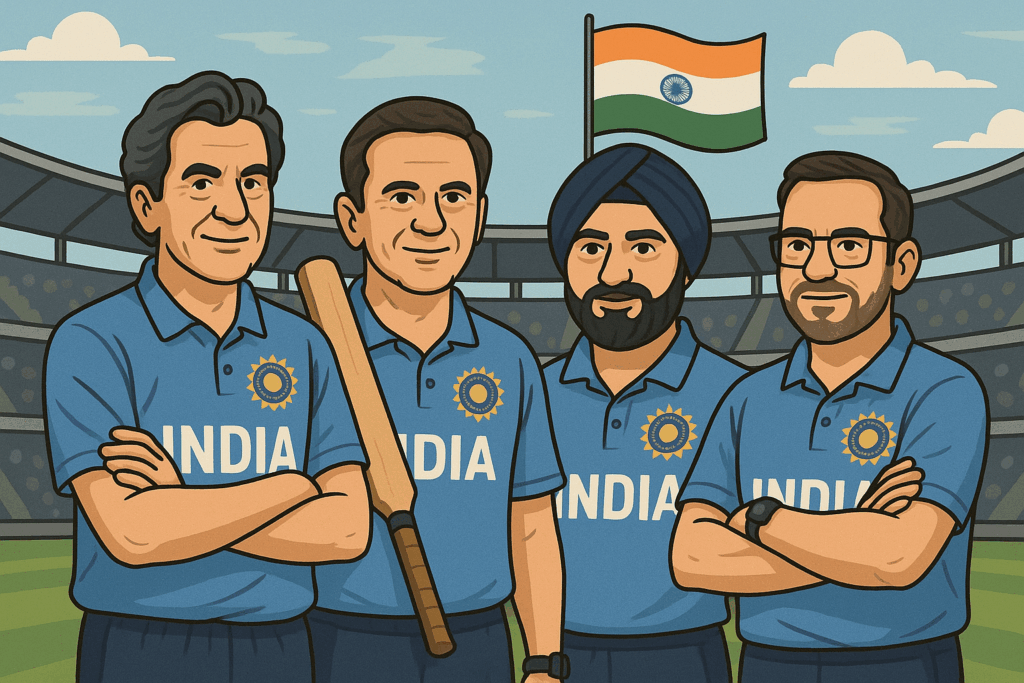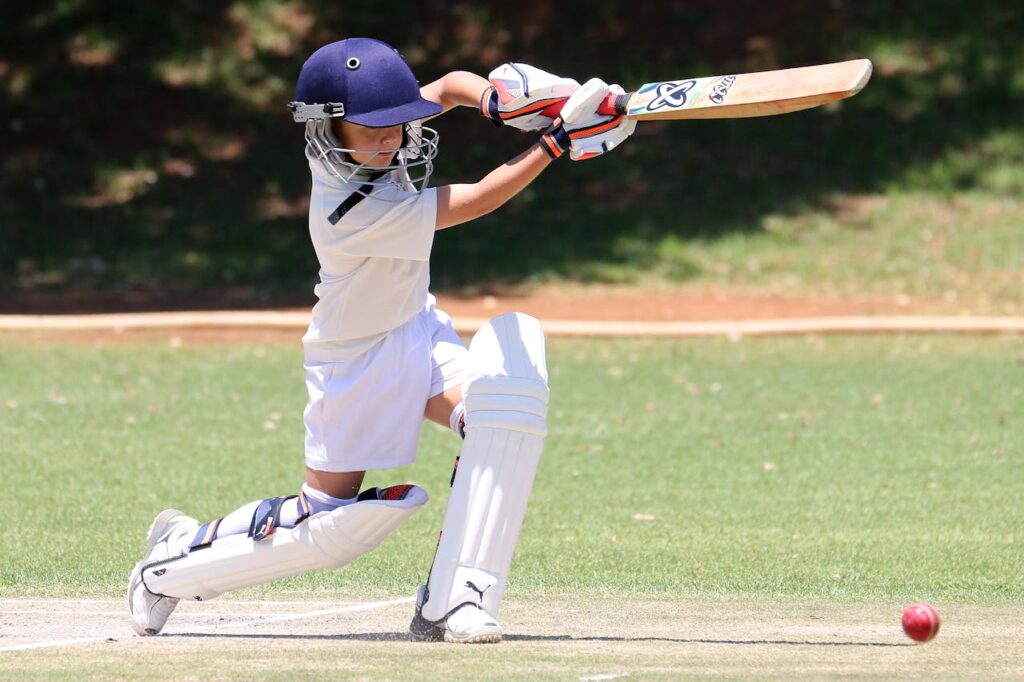When you think of the India national cricket team, visceral memories come flooding back — a Sachin square cut, a Kohli cover drive, Dhoni’s helicopter shot sailing into the crowd. But behind every iconic moment lies a tactician in the dressing room, a guide who aligns talent with purpose. The unsung architects — the coaches — are far more than just support staff. They are visionaries, mentors, and sometimes, crisis managers. Where captains lead the XI on the field, it’s the coaches who sculpt the cricketing soul of a nation off it.
In modern cricket, coaching isn’t about organizing drills or chalking out warmups. It’s about man-managing egos, nurturing raw potential, out-thinking opposition analysis, guiding team culture, balancing formats, and absorbing the pressure of a billion quiet expectations. The journey from India’s first official coach to today’s high-performance setups under the BCCI is a fascinating roadmap into how cricket in India evolved professionally.
This article offers an in-depth narrative on India National Cricket Team coaches — past and present — decoding their philosophies, legacies, controversies, and behind-the-scenes dynamics that shaped Indian cricket.
Who Is the Current Coach of India Cricket Team (2024)?
As of now, the head coach of the India national cricket team is Rahul Dravid. Known as ‘The Wall’ during his playing days, Dravid’s transition from batsman to mentor has been thoughtful rather than flashy — much like his batting.
Dravid took over the head coach role from Ravi Shastri, who helmed one of India’s most aggressive and tactically bold eras. Under Dravid, there’s been a noticeable return to technical discipline, emphasis on bench strength, and a deeper push into development pipelines — especially with the incorporation of India A and U19 graduates seamlessly into the senior team.
Dravid’s current coaching support staff includes:
- Paras Mhambrey (Bowling Coach)
- Vikram Rathour (Batting Coach)
- T. Dilip (Fielding Coach)
Let’s dig into the full list of India national cricket team coaches over the decades and how their styles reshaped Indian cricket.
India National Cricket Team Coaches: Complete List
India’s coaching timeline is a saga of transitions — from loosely-managed touring squads to today’s high-performance units with data analysts, mental conditioning specialists, and tactical coaches. Here’s a comprehensive table of Indian head coaches.
📋 Table: Full List of Head Coaches of Indian Men’s National Team
| Coach Name | Nationality | Tenure | Notable Achievements |
|---|---|---|---|
| Keki Tarapore | Indian | Brief stint | Coached during unofficial tours |
| Ashok Mankad | Indian | Short-term | Early experimentation era |
| Bishan Singh Bedi | Indian | Short term | Transitioned into coaching post-playing |
| Gundappa Viswanath | Indian | Interim Roles | Mentorship during turbulent transitions |
| Ajit Wadekar | Indian | Multiple Tenures | Strong ODI setup with Azharuddin |
| Kapil Dev | Indian | Short phase | Lack of structure under BCCI then |
| Anshuman Gaekwad | Indian | Two stints | Introduced mental aspects of preparation |
| John Wright | New Zealand | Early 2000s | Sparked India’s global self-confidence |
| Greg Chappell | Australian | Mid-2000s | Controversial era, polarizing legacy |
| Gary Kirsten | South African | Late 2000s | ODI World Cup triumph, mentor to Dhoni |
| Duncan Fletcher | Zimbabwean | Post-Kirsten | Strong tactical brain, aided in transition |
| Ravi Shastri | Indian | Multi-term (Team Director & Coach) | Aggressive cricket, Test wins abroad |
| Rahul Dravid | Indian | Current Coach | Grassroots pipeline cultivation |
Past Coaches of India Cricket Team: An Era-by-Era Perspective
🇮🇳 The Domestic Pioneers: Tarapore, Gaekwad, Wadekar
Indian cricket, until the late 90s, functioned without the kind of structured coaching hierarchy seen today. Coaches were more like tour managers or bureaucratic selections, often former cricketers appointed as caretakers. Ajit Wadekar, once credited for India’s overseas wins as captain, helmed a formative coaching phase between turbulent captaincies of Azharuddin and Ganguly.
Anshuman Gaekwad, known for his gritty style, tried to instill discipline and technical improvement. But with no performance analytics, fitness frameworks, or coaching models to refer to, their hands were tied. Nevertheless, they laid groundwork for what would eventually become a modern coaching setup.
🌍 The Foreign Infiltration: John Wright to Gary Kirsten
If there’s one coach who changed the very DNA of Indian cricket, it’s John Wright. Appointed in the early 2000s, Wright was India’s first-ever foreign head coach. He respected Indian cricket’s emotional intensity but added structure, accountability, and most importantly — belief. His chemistry with Sourav Ganguly was pivotal. Together, they sowed the seeds of fearless cricket.
Tour wins in Australia, the drawn epic at Eden Gardens against Steve Waugh’s invincibles, and a Champions Trophy final — Wright elevated India to a solid global side.
Then came Greg Chappell — perhaps the most divisive figure to ever be in charge. Chappell wanted radical reforms: fitness-first, youth over experience, and top-down authority. His fallout with Ganguly triggered one of Indian cricket’s ugliest leadership dramas. The team’s performances dipped and dissent grew. A forgettable World Cup, first-round exit, and putrid dressing-room environment defined Chappell’s tenure.
Gary Kirsten, in contrast, was balm after Chappell’s storm. Calm, measured, and incredibly player-focused, he let Dhoni grow into one of India’s most legendary leaders. Alongside Paddy Upton, Kirsten introduced personalized mental prep, peak conditioning cycles, and a game-centric prep system. Their crowning moment: ODI World Champion.
🔥 Tactical Aggression: The Ravi Shastri Era
If Wright gave India belief and Kirsten gave finesse, Ravi Shastri brought swagger. A former commentator and Team Director, Shastri was never short of words or energy. Under him, India became a formidable Test side — beating Australia in back-to-back away series.
He reshaped India’s bowling culture, encouraged pace aggression courtesy of Jasprit Bumrah, Siraj, and Shami, and disrupted the dominance of spin-first mindsets. White-ball success was moderate, and ICC silverware success eluded him, but his tenure reinvigorated patriotism in longer formats.
Shastri often operated more as man-manager than technique coach. He was there to make the boys ‘feel bulletproof,’ as he once put it.
🛡️ Rahul Dravid: Patience Meets Precision
Today, Dravid’s coaching philosophy is molded by his years at the National Cricket Academy. He oversaw India A and Under-19 setups, nurturing superstars like Shubman Gill, Prithvi Shaw, and Ruturaj Gaikwad. As head coach, Dravid’s focus is longer-term — refining structures, managing workloads, and preparing backups.
There’s less chest-thumping now and more chess-thinking. His quiet words may not lift stadiums like Shastri’s rants, but they sharpen the next generation’s clarity.
Foreign vs Indian Coaches: What the Data Suggests
A fair question often debated — have India done better under foreign tacticians?
🔍 Performance Snapshot Table:
| Coach Nationality | Notable Accomplishments | Challenges |
|---|---|---|
| Indian Coaches | Better cultural compatibility; long-term vision | May lack external tactical diversity |
| Foreign Coaches | Modern methods, overseas success | Sometimes misinterpret Indian team dynamic |
| Gary Kirsten | World Cup win + transformative methods | Retired soon after peak |
| Greg Chappell | Data-driven & radical, but combustible | Poor man-management |
| Ravi Shastri | Assertive Test performance, fearless cricket | Poor ICC finishes |
| Rahul Dravid | Youth-centric grooming | Needs ICC title win to seal legacy |
While foreign coaches brought systemic sharpness, India’s home-bred mentors brought sensibility. Both types succeeded and failed — depending on chemistry with captains.
Expansion Beyond Men’s Cricket: Women’s & U19 Coaches
India’s coaching structure has meaningfully diversified. The India U19 Cricket Team Coach now commands immense attention due to players fast-tracked from junior to senior setup.
Notable examples:
- Under Rahul Dravid, India U19 produced multiple future stars.
- Hrishikesh Kanitkar briefly coached a young ODI side during senior player rest periods.
For the Indian Women’s Team, progress was slow but is finally getting systemic attention. The appointment of high-caliber coaches, including WV Raman and most recently Amol Muzumdar, signals a professionalism boost. The women’s team, now under the BCCI fully, has started receiving parallel treatment with a growing coaching infrastructure.
BCCI Coaching Appointment: How It Works
Appointing the head coach of the India national cricket team is no informal affair. It’s handled by the Cricket Advisory Committee (CAC) — a BCCI-appointed group sanctioned by its constitution. The process includes:
- Open Applications: Candidates apply or are scouted.
- Shortlist & Interview: Coaching philosophy, record, communication style, and team compatibility are evaluated.
- Appointment Approval: Final appointment is publicly announced.
Recent appointments, such as Dravid’s, reflect a renewed focus on grooming internal talent with continuity from U19 to national level.
How to Become India Cricket Team Coach?
The role isn’t bought; it’s earned through rigorous cricketing and coaching experience.
Pathways:
- Play at first-class or international level
- Earn accredited coaching certificates (Level A–C by ICC/BCCI)
- Coach at domestic/Ranji level or India A/U19
- Build reputation in IPL or domestic coaching circuits
- Get shortlisted via BCCI notification & interview
Many ex-cricketers turn to coaching, but few possess the leadership, empathy, and cricketing IQ required for the national team.
Legacy Moments That Defined Indian Coaches
Here are turning points that highlight the influence India’s cricket team coaches have had:
- Wright-Ganguly choke over Australia at Eden
- Kirsten-Dhoni’s soft guidance to 50-over glory
- Shastri rousing the team from COVID chaos to Brisbane conquest
- Dravid blooding five debutants in one ODI post-quarantine — all confident
These aren’t mere stats. They’re cultural imprints, sketched by men who transitioned the team from playing for respect to becoming title contenders across all formats.
Final Over: Why Coaches Matter in Indian Cricket
The head coach of the Indian cricket team is more than a tactician. He’s part philosopher, consultant, referee, friend, and motivator — shouldering as much blame in defeat as players face. From garlanded praise to vitriolic criticism, their presence is essential, yet often misunderstood.
Amid glittering centuries and screaming deliveries, the coaches remain in the wings, pulling strings, managing moods, and planting winning mindsets.
Who follows Dravid? Time will tell. But whoever steps next must not only read data sheets or master drills — they must, above all, understand what cricket means to India.
🧠 Key Takeaways
- India’s coaching history reflects its cricketing transformation — from amateurism to excellence.
- Foreign coaches brought modernity and discipline; Indian coaches offered understanding and stability.
- Rahul Dravid is the current coach and represents a developmental continuity model.
- Coaching systems are now replicated across men’s, women’s, and U19 teams with shared philosophies.
- Coaches today must balance analytical acumen with emotional intelligence — it’s a 360° role.
❓FAQs about India National Cricket Team Coaches
- Who is the current coach of India cricket team?
- Rahul Dravid is the head coach as of now.
- How many foreign coaches has India had?
- Five officially — John Wright, Greg Chappell, Gary Kirsten, Duncan Fletcher, and one interim stint by Lalchand Rajput under foreign support staff setup.
- Who was the first coach of India cricket team?
- Keki Tarapore is considered one of the early unofficial tour coaches. Structured assignments began with John Wright.
- What qualification is needed to become India’s head coach?
- BCCI Level C certification, high-level playing or coaching experience, and a strong track record managing elite teams.
Want detailed analysis of India U19 or women’s coach systems next? Let us know.
🖊️ Written by a cricket journalist who’s followed the team from dusty Ranji fields to Lords’ balconies.


